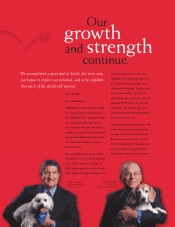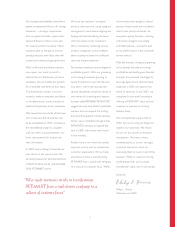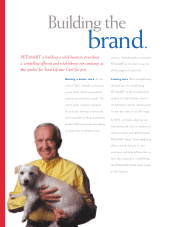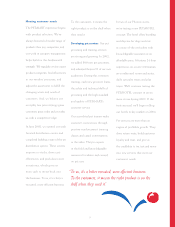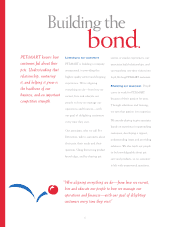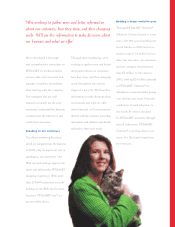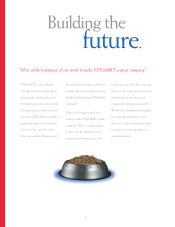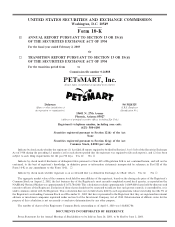Petsmart 2002 Annual Report Download - page 14
Download and view the complete annual report
Please find page 14 of the 2002 Petsmart annual report below. You can navigate through the pages in the report by either clicking on the pages listed below, or by using the keyword search tool below to find specific information within the annual report.store easier to shop and allows our associates to spend more time serving customers. As of February 2, 2003,
we had approximately 400 stores, or 69% of our total store base, in the new format. We plan to complete the
stores targeted for the reformatting program by the end of 2003. We believe these strategic initiatives will
continue to drive enhanced comparable store sales growth, proÑtability, and return on investment.
The Pet Food and Pet Supply Industry
The pet product industry serves a large and growing market. In 2001, the Business Communications
Company, Inc., which conducts surveys every two years, estimated the market for pet and equine products and
supplies, including services, to be approximately $29 billion. Pets, including Ñsh, have become increasingly
prevalent in United States households. There are approximately 68 million dogs and 73 million cats in United
States households based on the 2001 American Pet Product Manufacturers Association, or APPMA, National
Pet Owners Survey. Demand for pets is largely inÖuenced by family formation as more than 35% of all pets are
owned by families with children. Sixty-two percent of United States households own a pet and 47% of those
households own more than one type of pet, according to APPMA.
Dog food, cat food, and treats represent the largest volume categories of pet-related products. Based on
information from Data & Research Services, plc., a company that specializes in automatic data capture
systems, we estimate that sales of dog food, cat food, and treats in the United States were approximately
$11.0 billion in 2001, up 6.2% from 2000. Based on information from Data & Research Services, plc., we
estimate that supermarket pet food brands, such as Purina, Pedigree, Alpo, and Friskies accounted for
approximately 63% of United States pet food sales in 2001. In recent years, supermarkets' share of total pet
food sales has decreased as a result of increased competition from superstores, club stores, mass merchandis-
ers, Internet retailers, and specialty pet stores as well as the growing proportion of sales of premium foods.
Based on information from Data & Research Services, plc., we estimate that premium pet food brands such as
Nutro, Science Diet, ProPlan, and Eukanuba, which oÅer higher levels of nutrition than non-premium brands,
accounted for approximately 37% of United States pet food sales in 2001. Many of these premium pet foods
are not currently sold through supermarkets, warehouse clubs, and mass merchandisers due to manufacturers'
restrictions, but are sold primarily through superstores, specialty pet stores, veterinarians, and farm and feed
stores.
United States sales of pet supplies, consisting of items such as dog and cat toys, collars and leashes, cages
and habitats, books, vitamins and supplements, shampoos, Öea and tick control, and aquatic supplies, were
approximately $5.1 billion in 2000, up 33% over 1996, according to Packaged Facts, a consumer market
research company. Packaged Facts projects sales growth in supplies at 6% annually, exceeding $6.8 billion by
2005.
Merchandise
Merchandise, which represented approximately 94%, 95%, and 96% of our retail revenues in 2002, 2001,
and 2000, respectively, generally falls into three main categories:
‚Pet Food, Treats and Litter. We emphasize premium dog and cat foods, many of which are not
available in supermarkets, warehouse clubs or mass merchandisers. We also oÅer quality national
brands traditionally found in supermarkets and pet stores. The sale of pet food, treats, and litter
comprised approximately 42%, 45%, and 44% of our retail revenues in 2002, 2001, and 2000,
respectively.
‚Pet Supplies and Other Goods. Our broad assortment of pet supplies includes collars, leashes, health
and beauty aids, shampoos, medication, toys, pet carriers, dog houses, cat furniture, and equestrian
supplies. We also oÅer a complete line of supplies for Ñsh, birds, and small pets, including aquariums,
Ñlters, birdcages, and small pet supplies. We have an equine department in certain stores that serves
trade areas with high rates of horse ownership. The sale of pet supplies and other non-pet supply goods
comprised approximately 49%, 46%, and 49% of our retail revenues in 2002, 2001, and 2000,
respectively.
2


